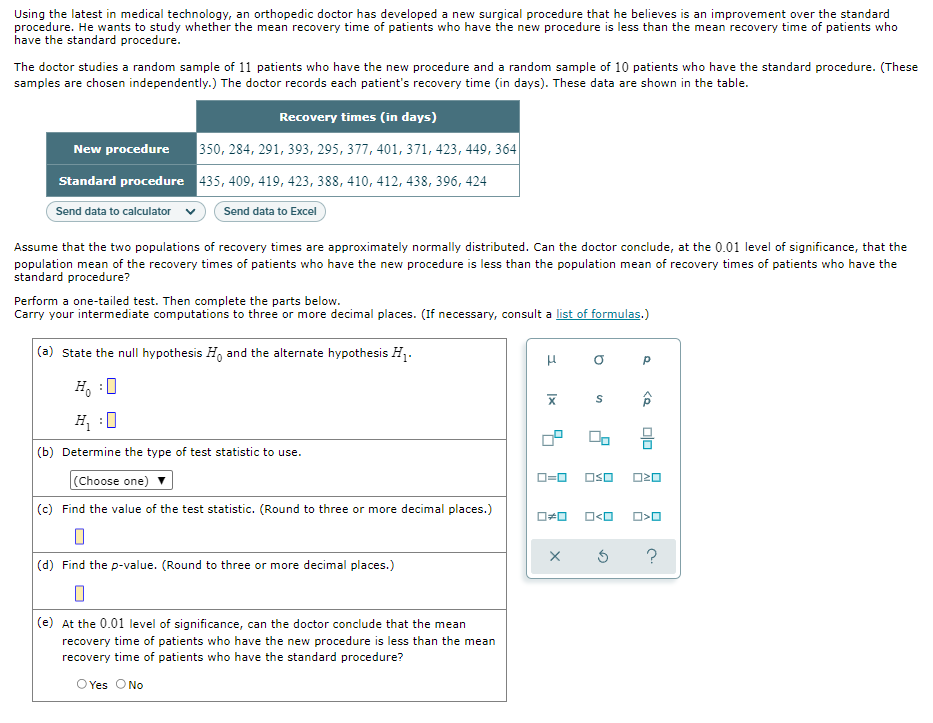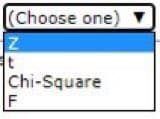Using the latest in medical technology, an orthopedic doctor has developed a new surgical procedure that he believes is an improvement over the standard procedure. He wants to study whether the mean recovery time of patients who have the new procedure is less than the mean recovery time of patients who have the standard procedure. The doctor studies a random sample of 11 patients who have the new procedure and a random sample of 10 patients who have the standard procedure. (These samples are chosen independently.) The doctor records each patient's recovery time (in days). These data are shown in the table. Recovery times (in days) 350, 284, 291, 393, 295, 377, 401, 371, 423, 449, 364 New procedure Standard procedure 435, 409, 419, 423, 388, 410, 412, 438, 396, 424 Send data to calculator Send data to Excel Assume that the two populations of recovery times are approximately normally distributed. Can the doctor conclude, at the 0.01 level of significance, that the population mean of the recovery times of patients who have the new procedure is less than the population mean of recovery times of patients who have the standard procedure? Perform a one-tailed test. Then complete the parts below. Carry your intermediate computations to three or more decimal places. (If necessary, consult a list of formulas.) (a) State the null hypothesis Ho and the alternate hypothesis H₁. Р HO S : On I |x L 9
Using the latest in medical technology, an orthopedic doctor has developed a new surgical procedure that he believes is an improvement over the standard procedure. He wants to study whether the mean recovery time of patients who have the new procedure is less than the mean recovery time of patients who have the standard procedure. The doctor studies a random sample of 11 patients who have the new procedure and a random sample of 10 patients who have the standard procedure. (These samples are chosen independently.) The doctor records each patient's recovery time (in days). These data are shown in the table. Recovery times (in days) 350, 284, 291, 393, 295, 377, 401, 371, 423, 449, 364 New procedure Standard procedure 435, 409, 419, 423, 388, 410, 412, 438, 396, 424 Send data to calculator Send data to Excel Assume that the two populations of recovery times are approximately normally distributed. Can the doctor conclude, at the 0.01 level of significance, that the population mean of the recovery times of patients who have the new procedure is less than the population mean of recovery times of patients who have the standard procedure? Perform a one-tailed test. Then complete the parts below. Carry your intermediate computations to three or more decimal places. (If necessary, consult a list of formulas.) (a) State the null hypothesis Ho and the alternate hypothesis H₁. Р HO S : On I |x L 9
Holt Mcdougal Larson Pre-algebra: Student Edition 2012
1st Edition
ISBN:9780547587776
Author:HOLT MCDOUGAL
Publisher:HOLT MCDOUGAL
Chapter11: Data Analysis And Probability
Section: Chapter Questions
Problem 8CR
Related questions
Question

Transcribed Image Text:Using the latest in medical technology, an orthopedic doctor has developed a new surgical procedure that he believes is an improvement over the standard
procedure. He wants to study whether the mean recovery time of patients who have the new procedure is less than the mean recovery time of patients who
have the standard procedure.
The doctor studies a random sample of 11 patients who have the new procedure and a random sample of 10 patients who have the standard procedure. (These
samples are chosen independently.) The doctor records each patient's recovery time (in days). These data are shown in the table.
Recovery times (in days)
350, 284, 291, 393, 295, 377, 401, 371, 423, 449, 364
New procedure
Standard procedure
435, 409, 419, 423, 388, 410, 412, 438, 396, 424
Send data to calculator
Send data to Excel
Assume that the two populations of recovery times are approximately normally distributed. Can the doctor conclude, at the 0.01 level of significance, that the
population mean of the recovery times of patients who have the new procedure is less than the population mean of recovery times of patients who have the
standard procedure?
Perform a one-tailed test. Then complete the parts below.
Carry your intermediate computations to three or more decimal places. (If necessary, consult a list of formulas.)
(a) State the null hypothesis Ho and the alternate hypothesis H₁.
H
Р
X
S
HO
H₁ :0
(b) Determine the type of test statistic to use.
(Choose one)
ローロ OSO
(c) Find the value of the test statistic. (Round to three or more decimal places.)
0
(d) Find the p-value. (Round to three or more decimal places.)
0
(e) At the 0.01 level of significance, can the doctor conclude that the mean
recovery time of patients who have the new procedure is less than the mean
recovery time of patients who have the standard procedure?
O Yes O No
|x
☐#0 O<O
X
<Q
00
O>O
?

Transcribed Image Text:(Choose one) ▼
Z
t
Chi-Square
F
Expert Solution
This question has been solved!
Explore an expertly crafted, step-by-step solution for a thorough understanding of key concepts.
This is a popular solution!
Trending now
This is a popular solution!
Step by step
Solved in 2 steps with 2 images

Recommended textbooks for you

Holt Mcdougal Larson Pre-algebra: Student Edition…
Algebra
ISBN:
9780547587776
Author:
HOLT MCDOUGAL
Publisher:
HOLT MCDOUGAL

Glencoe Algebra 1, Student Edition, 9780079039897…
Algebra
ISBN:
9780079039897
Author:
Carter
Publisher:
McGraw Hill

College Algebra (MindTap Course List)
Algebra
ISBN:
9781305652231
Author:
R. David Gustafson, Jeff Hughes
Publisher:
Cengage Learning

Holt Mcdougal Larson Pre-algebra: Student Edition…
Algebra
ISBN:
9780547587776
Author:
HOLT MCDOUGAL
Publisher:
HOLT MCDOUGAL

Glencoe Algebra 1, Student Edition, 9780079039897…
Algebra
ISBN:
9780079039897
Author:
Carter
Publisher:
McGraw Hill

College Algebra (MindTap Course List)
Algebra
ISBN:
9781305652231
Author:
R. David Gustafson, Jeff Hughes
Publisher:
Cengage Learning